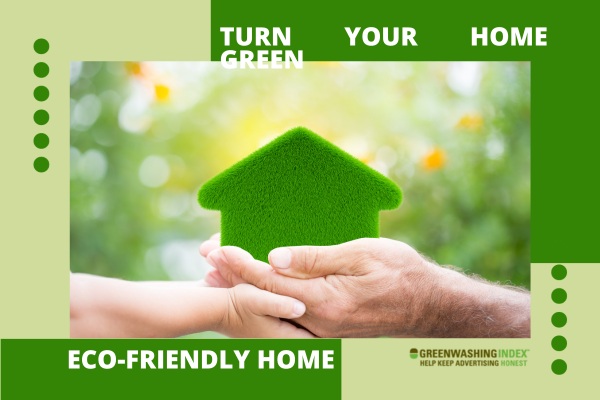

As someone who cares about the planet, have you ever asked yourself how you can make your eco-friendly home dreams a reality? If so, then I’m guessing that you’re looking for simple and feasible ways to start. The good news is, that it’s totally possible to transform your living spaces into green homes, and you’ve just landed in the right place to get started!
Turning your house into an eco-friendly home means integrating sustainable practices into your everyday life. From creating a more energy-efficient environment to reducing waste and choosing non-toxic products—every small step goes a long way.
To help you on this journey towards sustainable living, here’s a straightforward guide with 10 easy steps that will not only minimize your carbon footprint but also save you in the process!
What You’ll Gain Here:
Transforming your living space into an eco-friendly home is perhaps one of the most significant steps you can take towards sustainable living. It may sound like a daunting task but don’t worry. With a few minor changes and swaps, we can all participate in creating a healthier environment. Let’s explore ten attainable steps to achieve this differing lifestyle:

With approximately 75% less energy being used as compared to standard incandescent lights, LED bulbs are a fantastic and easily implemented method of enhancing energy efficiency in your home. Not only will this significantly reduce your overall power demand, but the lasting durability of these LEDs translates to fewer replacements and thus reduces waste as well.
Implementing low-flow showerheads and toilets is a surefire way of saving substantial amounts of water every day. This not only conserves a crucial resource but also simultaneously cuts back on your monthly utility expenses, thereby making it an incredibly worthwhile investment.
Composting is an effective method to both reduce household wastage and improve soil quality by recycling food scraps into nutrient-enriched soil through natural decomposition over time.

By using homemade cleaning solutions created from natural ingredients like vinegar, lemon juice, or baking soda, you can maintain cleanliness without subjecting yourself or the environment to harmful chemicals found in many store-bought products.
Using solar-powered chargers can significantly reduce your dependence on electricity generated from fossil fuel resources which often have detrimental environmental effects.
By substituting disposable plastic shopping bags with reusable alternatives, you can substantially decrease plastic waste contributing towards landfill accumulation or marine pollution.

Choosing bamboo products over their traditional plastic alternatives fosters sustainable farming practices while also helping to reduce damaging waste creation.
Energy-efficient appliances minimize power consumption noticeably contributing towards reduced utility bills and improving your carbon footprint collectively making them a highly beneficial purchase in the long term.
Guide:
Conventional disposable diapers constitute an alarming amount of landfill waste. In contrast, cloth diapers can be washed and reused, significantly reducing this contribution to landfill waste.
Steps:
Step 1: Consider the feasibility of switching to cloth diapers for your child
Step 2: Purchase a set of quality cloth diapers
Step 3: Pertinently wash and sanitize these cloth diapers after each use.

Consuming organic food promotes sustainable farming practices while ensuring that what we ingest is free from harmful agricultural chemicals. Furthermore, buying organic food generates vital income for local farmers dedicated to maintaining such ethical farming methods.
Process:
Living in an eco-friendly home isn’t just about the physical modifications we make to our environment; it’s a way of life. It requires a committed mindset and an understanding that each small step we take contributes to the bigger picture.
Consistency is key when cultivating an eco-friendly lifestyle. Just like hitting the gym or learning a new language, our dedication and daily actions greatly influence our progress.
Maintaining eco-conscious decisions every day forms good habits, reducing our carbon footprint over time.
In the pursuit of going green, technological developments have played a significant role. Embracing these advancements can make our homes smarter, more efficient, and kinder to Mother Earth.

The appeal of transforming one’s home into an eco-friendly haven stems not only from an environmental perspective but also from a financial standpoint. Incorporating such technologies aids in energy conservation resulting in affordable utility bills. Here are some modern tech solutions that help create an eco-friendly home:
Choosing an eco-friendly home is not merely about following the latest trend; it’s a lifestyle shift with expansive benefits. More than being good for your conscience, a green home can be good for your health and your wallet. Let’s delve into why sustainability at home truly matters.
Living in an eco-friendly home provides countless advantages. Here are my top reasons to transition towards this lifestyle:
In essence, an eco-friendly lifestyle can make you healthier while saving money and resources- what’s not to love?
Adopting an eco-conscious lifestyle throughout our homes significantly reduces the adverse effects we have on our environment:
An eco-friendly home, or a sustainable living space, focuses on minimizing harmful impacts to the environment by maximizing energy efficiency, water conservation, and waste reduction through using non-toxic products and natural cleaning solutions.
You can make your house more environmentally friendly without breaking the bank by opting for energy-efficient LED light bulbs, using water-saving appliances, composting kitchen waste at home and switching to reusable shopping bags.
Long-term benefits of an eco-friendly home include substantial savings on utility bills due to increased energy efficiency and reduced water usage. Additionally, it provides a healthier living environment due to less exposure to chemicals and toxic materials.
You can reduce your carbon footprint at home by switching to renewable sources of energy like solar power. Invest in energy-efficient appliances, lower water consumption with efficient fixtures, and cultivate habits like composting and recycling.
Living in an eco-friendly home isn’t only a rising trend but a responsibility we all share for the health of our planet. Sustainable living is about making conscientious choices that help reduce pollution, conserve resources, and promote environmental preservation.
The journey to creating an inclusive environment begins at home. Every step towards an eco-friendly home sends ripples of change, encouraging others and ultimately co-creating a healthy world for generations to come.
